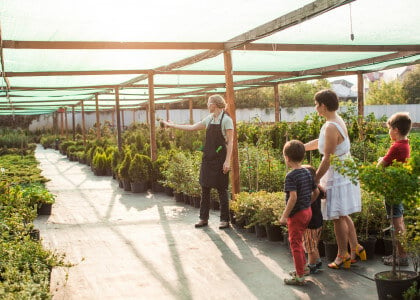Planting yourself can be a great way to save money and spend time outside in your yard. However, there are many mistakes that people make when looking for, buying, and planting plants, which leads to disappointment. Avoid the headache and follow these tips to help avoid the most common mistakes people make when planning and planting.
 Plants Pictured: Taylor Juniper (upright), Blue Oat Grass,
Plants Pictured: Taylor Juniper (upright), Blue Oat Grass,
Autumn Joy Sedum, Variegated Iris,
Robust Male Fern, Pagoda Dogwood, Burning Bush
1. Survey the site before planting. Be sure to look at the distance from any structures (house/sidewalks), the air circulation, the soil drainage, growing conditions, climate, etc. Make sure you buy plants that work in your area and growing conditions. Research what soil, sun, and weather conditions are best for the plants you are considering so you don’t end up with dead plants!
2. Plan how your yard will look year-round. Consider when your plants hit their peak and how long they last. By planning this out you won't end up with a static yard, something will always be in bloom.
3. Think of height. Research how tall (and wide) things will grow so you don’t end up with things too tall/short for an area. Pruning is NOT intended to cut plants down to fit the area you want, so make sure ahead of time that your plant is the correct height for your area. Also, having a variety of heights can add diversity to your landscape, so be sure to think of the view as a whole as well.
4. Consider plant–dropping habits. Find out how much you will have to be cleaning up after it; some plants drop a lot more than others, so find the plant whose habits are suited to your needs.
5. Consider maintenance. If you don’t enjoy yard work, don’t pick plants that require consistent pruning or upkeep. Instead, pick plants that are relatively low maintenance.
6. Add a stake if top heavy or small. If your new tree is on a slant, place a stake with it so that it grows upright. Growing sideways can cause problems in the future. However, make sure the rope/twine/whatever you wrap around the tree is loose and stays that way. If it is tight it can cause what is known as girdling, which is when something is so tight around a branch/trunk that it strips away the bark and kills that branch and everything above it.
 Photo Credits: Preservation Tree, The Kansas City Star
Photo Credits: Preservation Tree, The Kansas City Star
7. Grow your plants far enough apart. If plants are grown too close together the plants and roots can run into each other causing serious problems. (It may take some time for plants to grow to full size, so you can use annuals in the beginning years to fill any gaps you may have.)

Forest Rouge Viburnum (shrub form trimmed), Blue Ice Amsonia
8. MOST IMPORTANTLY: Do your research before you buy! A little work beforehand will guarantee that you will be fully satisfied with your yard!

